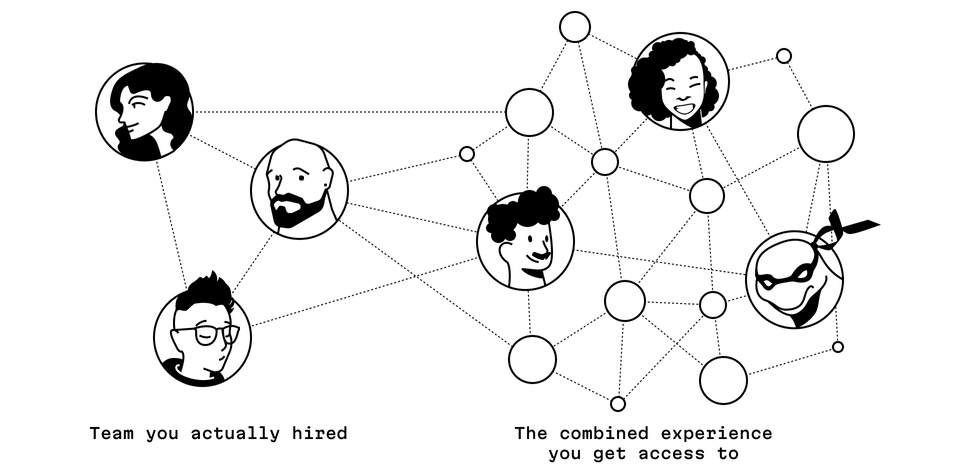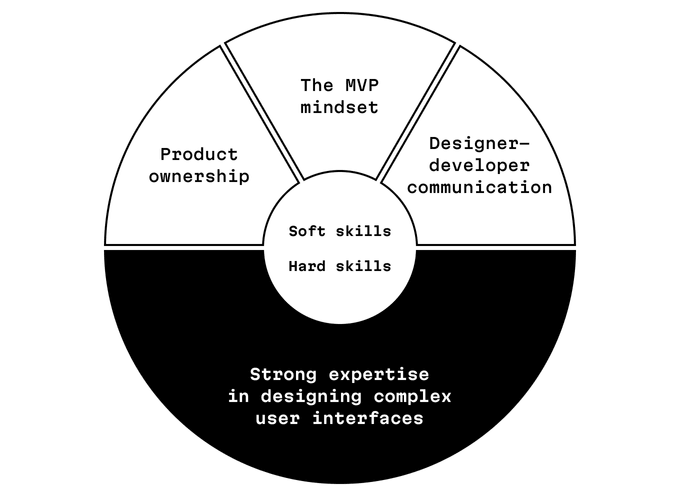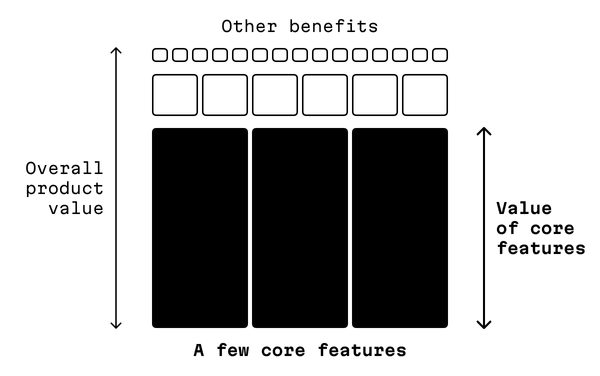Hiring a product designer: 1 hard skill and 3 soft skills to look for

Topics
I’ve spent more than fifteen years hiring, mentoring, and evaluating product designers, and working with startups for nearly the same amount of time. When it comes to hiring that first designer, a founder’s challenge is finding a candidate who is not only a good fit for the startup at an early stage, but one who also has the potential to become a future head of product. This is tough because early-stage companies require a unique set of skills from candidates; the good news is that this challenge can be overcome, and in this article, I’ll help you successfully navigate it.
No product-market fit? Consider hiring a consultancy first
Time is not on a startup’s side. The company needs traction urgently, and the best time to release anything was yesterday. As a first step, I always recommend finding the best product development consultancy available and hiring them to kickstart the development of an MVP. While the consultancy propels your company forward, you’ll have the time needed to build an in-house team.
Despite the costs, consultancies are exceptionally effective for pre-product-market-fit companies. They can start delivering value from day one, leveraging their collective experience from numerous projects.
When you hire a consultancy team, you’re essentially tapping into the combined expertise of all its team members, kind of like the Na’vi from Avatar. It’s like having a super team on your side with a combined knowledge derived from hundreds of projects.

Moreover, these teams are well-coordinated and work seamlessly together; designers and engineers on these teams often have years of collaborative experience, sometimes even spanning decades. Effective communication is vital for rapid development, making a team hire a more valuable choice than merely hiring individual “hands.”
Crafting the perfect product designer for a developer-focused company
Moving on to hiring a product designer, I recommend looking for candidates who possess one hard skill and three soft skills. The sole hard skill required is a strong expertise in designing complex user interfaces. The soft skills you should seek are: having an MVP mindset, taking ownership of the product, and effective designer-developer communication.

The essential skillset of a DevTool product designer
Ideally, your candidate should already possess all three of these soft skills. While it is possible to teach them, based on my experience, this is no easy task and demands special effort and experience. So, make an effort to assess if your potential candidate already possesses as many of these skills as possible.
The hard skill: strong expertise in designing complex user interfaces
While all product designers have experience in designing user interfaces, you specifically need those who: 1) have a track record of working with complex interfaces for professional use and 2) have developed a high level of expertise in this area.
First, by “complex” interfaces, I mean those which are made for professional use by developers and engineers. These UIs are usually feature rich and contain a high density of things like buttons, inputs, and selects, and also often include tables, dashboards, and panels for properties and navigation. How to practically measure this? In a perfect world, your successful candidate should have designed at least two different applications that fit this definition of complexity.

A few examples of UIs made for professionals and for consumers
Second, their expertise designing these complex UIs should be fairly robust. While learning to design user interfaces isn’t rocket science, it does take some number of years to accumulate sufficient experience. Since people progress at different rates, I would recommend seeking candidates with at least 5 to 8 years of software design experience.
While I can provide some clues and signals to spot a designer who holds the “strong expertise + complex UIs” combination, this can still be a challenge, so it’s a good idea to engage an experienced designer and have them thoroughly evaluate the candidate’s skills. We’ll nevertheless discuss these clues and signals in the second part of this article.
Soft skill #1: the MVP mindset
Everything comes down to scoping, and product designers with the MVP mindset have the ability to take a founder’s vision as input, break it down into its essential features, identify the most crucial subset of these features that form the product’s core, and then create a step-by-step plan for delivering a valuable version of your product to your initial users or design partners.

An ideal MVP is built over a very few core features that deliver the majority of value to the customer
Soft skill #2: taking ownership of the product
From the designer’s perspective, it all begins with a sense of involvement. Good designers show a strong interest in every decision related to the product, naturally taking control and responsibility for feature delivery and product launch.
Great product designers immerse themselves so deeply that they actually become co-authors of the product they’re developing.
Often, when founders place their trust in a designer of this caliber, they go on to become excellent heads of product as the company grows.
Soft skill #3: effective designer-developer communication
To put it plainly, effective designer-developer communication involves two key aspects: first, the designer should be open to regularly sharing their design concepts and displaying their work-in-progress designs to the product team; second, the designer should be prepared to encourage the entire UI team to make the kind of technical decisions that prioritize the best user experience over ease of technical implementation.
The readiness to discuss designs and challenge engineers results in several positive outcomes. For instance, it reduces the time required to align designs with technical constraints. Additionally, involving the engineering team in the feature design process naturally unites the product team.
Nice-to-have qualities
Beyond these essential skills, it’s also beneficial if the designer possesses expertise in data visualization, especially since professional-use UIs often feature dashboard screens or use tables and graphs to present data.
It’s also valuable if the designer is proactive and willing to work without a backlog. This means they should be ready to ask the founding team for their rough vision instead of waiting for processed information provided through Linear or Jira tickets.
Another positive quality is a designer’s willingness to learn and consider feedback from users.
UX research for dev tools must not be neglected: our quick-start guide

Experience working with analytics, formulating product hypotheses, defining metrics, and analyzing user behavior data to measure results is another valuable asset.
Finally, if a designer has knowledge about adopting a design system in order to keep their designs scalable, this can be advantageous.
Should a designer working on a DevTool product know how to code?
No, not strictly.
However…
…communication within the product team improves when a designer is acquainted with the technical stack (to a sufficient level so that they could create a basic application with it).
Let’s wrap up this first part with a recap. Consider hiring an agency if you’re in the Product-Market Fit stage, and seek an experienced and proactive designer who can potentially evolve into a head of product by prioritizing the hard skill and the soft skills I outlined here. Don’t forget to consider their future evolution within the company, and remember the “nice to have” qualities, too.
In the next part, we’ll discuss setting up the job posting, the screening process, conducting interviews that attract the right type of designers, and how to evaluate their suitability for the position.
We’re enthusiastic and ready to chat and offer strategic advice on designing your early-stage product. Feel free to reach out with any questions, and let’s have a conversation!


